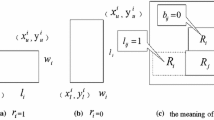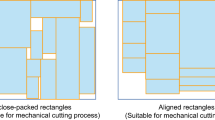Abstract
In this study, two approaches are explored for the solution of the rectangular stock cutting problem: neuro-optimization, which integrates artificial neural networks and optimization methods; and genetic neuro-nesting, which combines artificial neural networks and genetic algorithms. In the first approach, an artificial neural network architecture is used to generate rectangular pattern configurations, to be used by the optimization model, with an acceptable scrap. Rectangular patterns of different sizes are selected as input to the network to generate the location and rotation of each pattern after they are combined. A mathematical programming model is used to determine the nesting of different sizes of rectangular patterns to meet the demand for rectangular blanks for a given planning horizon. The test data used in this study is generated randomly from a specific normal distribution. The average scrap percentage obtained is within acceptable limits. In the second approach, a genetic algorithm is used to generate sequences of the input patterns to be allocated on a finite width with infinite-length material. Each gene represents the sequence in which the patterns are to be allocated using the allocation algorithm developed. The scrap percentage of each allocation is used as an evaluation criterion for each gene for determining the best allocation while considering successive generations. The allocation algorithm uses the sliding method integrated with an artificial neural network based on the adaptive resonance theory (ART1) paradigm to allocate the patterns according to the sequence generated by the genetic algorithm. It slides an incoming pattern next to the allocated ones and keeps all scrap areas produced, which can be utilized in allocating a new pattern through the ART1 network. If there is a possible match with an incoming pattern and one of the scrap areas, the neural network selects the best match area and assigns the pattern. Both approaches gave satisfactory results. The second approach generated nests having packing densities in the range 95–97%. Improvement in packing densities was possible at the expense of excessive computational time. Parallel implementation of this unconventional approach could well bring a quick and satisfactory solution to this classical problem.
Similar content being viewed by others
References
Adamowicz, M. and Albano, A. (1976) Nesting two-dimensional shapes in rectangular modules. Computer Aided Design, 18, 27–33.
Albano, A. and Sapuppo, G. (1980) Optimal allocation of two-dimensional irregular shapes using heuristic search methods. IEEE Transactions on Systems, Man and Cybernetics, 9, 302–310.
Carpenter, G. A. and Grossberg, S. (1985) Category learning and adaptive pattern recognition: a neural network model, in Proceedings Third Army Conference on Applied Mathematics and Computing, ARO Report, USA Army, 86(1), pp. 37–56.
Carpenter, G. A. and Grossberg, S. (1987) A massively parallel architecture for a self-organizing neural pattern recognition machine. Computer Vision Graphics Image Processing, 37, 54–115.
Chung, J., Scott, D. and Hillman, D. J. (1990) An intelligent nesting system on 2-D highly irregular resources, in Proceedings of Applications of Artificial Intelligence VIII 1293, International Society for Optical Engineering, pp. 472–483.
Dagli, C. H. (1988) Cutting stock problem: combined use of heuristic and optimization methods, in Recent Developments in Production Research, Mital A. (ed.), Elsevier, Amsterdam, pp. 500–506.
Dagli, C. H. (1990a) Neural network in manufacturing: possible impacts on cutting stock problem, in Proceedings 2nd International Conference on Computer Integrated Manufacturing, IEEE Computer Society Press, pp. 531–537.
Dagli, C. H. (1990b) Knowledge-based system for cutting stock problem. European Journal of Operation Research, 44, 160–166.
Dagli, C. H., Ashouri, R., Leininger, G. and McMillin, B. (1990) Composite stock cutting pattern classification through neo-cognitron, in Proceedings of International Joint Conference on Neural Networks, 2, p. 587.
Dagli, C. H. and Nisanci, I. H. (1981) A heuristic for cutting-stock problem, in Proceedings 6th International Conference on Production Research, International Foundation for Production Research, 1, pp. 9–16.
Dagli, C. H. and Tatoglu, M. Y. (1983) A computer package for solving cutting stock problems, in Proceedings 7th International Conference on Production Research, International Foundation for Production Research, 1, pp. 480–487.
Dagli, C. H. and Tatoglu, M. Y. (1987) An approach to two-dimensional cutting stock problems. International Journal of Production Research, 25, 175–190.
Davis, L. (1985) Applying adaptive algorithms to epistatic domains, in Proceedings of the International Joint Conference on Artificial Intelligence, IEEE Press, pp. 108–164.
GAMS (1988) General Algebraic Modeling System, The Scientific Press, Redwood City, California.
Garey, M. R. and Johnson, D. S. (1979) Computers and Inter-actability: A Guide to the Theory of NP-Completeness, W. H. Freeman and Company, San Francisco.
Goldberg, D. E. (1985) Alleles, loci, and the traveling salesman problem, in Proceedings of the First International Conference on Genetic Algorithms and Their Applications, Erlbaum, pp. 160–168.
Golden, B. L. (1976) Approaches to cutting stock problem. AIIE Transactions, 8(2) 256–274.
Haims, M. J. and Freeman H. (1970) A multistage solution of the template-layout problem. IEEE Transactions on System, Science, and Cybernetics, SSC-6, 145–151.
Hinxman A. I. (1980) The trim loss and assortment problems: a survey. European Journal of Operation Research, 5, 8–18.
NETS, (1989) Software Technology Branch, Lyndon B. Johnson Space Center, Houston, Texas.
Oliver, I. M., Smith, D. J. and Holland J. R. C. (1987) A study of permutation crossover operators on the traveling salesman problem, in Proceedings of the Second international Conference on Genetic Algorithms, Erlbaum, pp. 224–230.
Poshyanonda, P., Bahrami, A. and Dagli, C. (1992) Artificial neural networks in stock cutting problem, in Neural Networks in Manufacturing and Robotics, Shin, Y.C., Abodelmonen, A.H. and Kumara, S. (eds), ASME Press, New York, pp. 143–153.
Poshyanonda, P. and Dagli, C. (1992) A hybrid approach to composite stock cutting: neural networks and genetic algorithms, in Robotics and Manufacturing: Recent Trends in Research, Education and Applications, Vol. 4, Jashidi, M., Lumia, R., Mulling, J. and Shahinpoor, M. (eds), ASME Press, New York, pp. 775–780.
Schollmeyer, M., Lin, J. Q., Krishnamurthy, K., Barami, A., Leininger, G., Dagli, C. and Liou, F. (1991) Hybrid Expert system and operations research for solving nesting problems, in The World Congress on Expert Systems Proceedings, Pergamon Press, NY, pp. 1223–1231.
Spears, W. M. and De Jong, K. A. (1990) Using neural networks and genetic algorithms as heuristics for NP-complete problems, in Proceedings International Joint Conference on Neural Networks, IEEE, 1, p. 118–123.
Author information
Authors and Affiliations
Rights and permissions
About this article
Cite this article
DAGLI , C.H., POSHYANONDA , P. New approaches to nesting rectangular patterns. Journal of Intelligent Manufacturing 8, 177–190 (1997). https://doi.org/10.1023/A:1018517106992
Issue Date:
DOI: https://doi.org/10.1023/A:1018517106992




